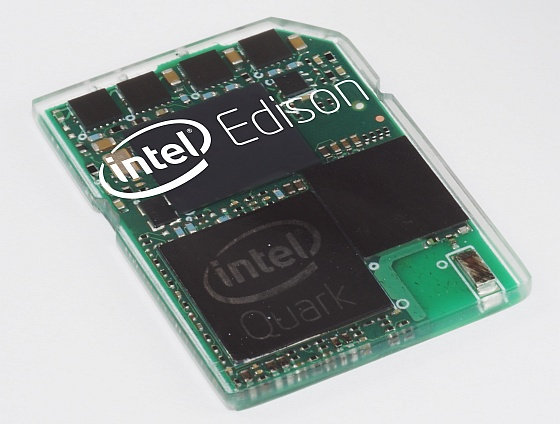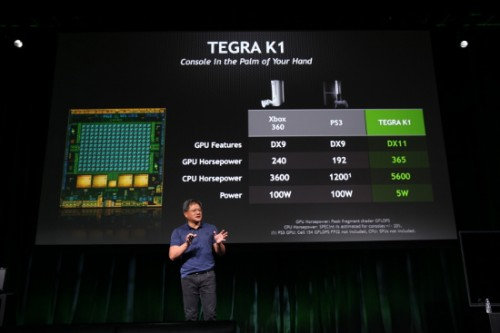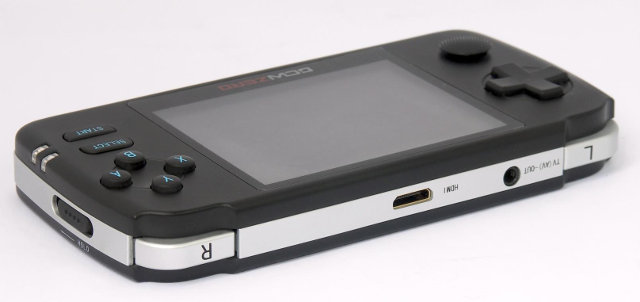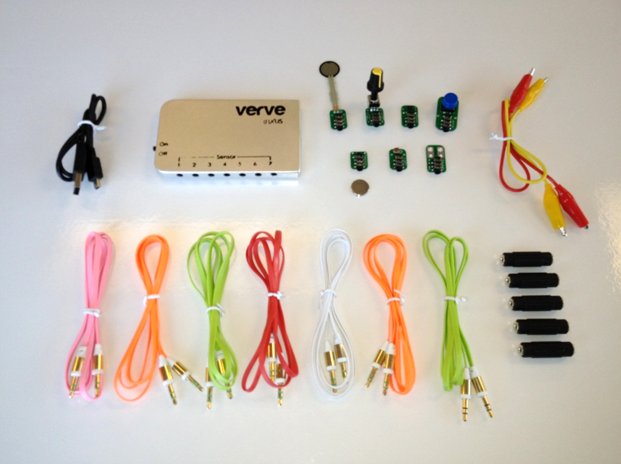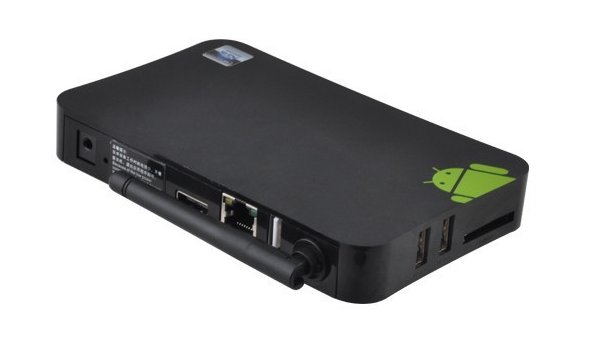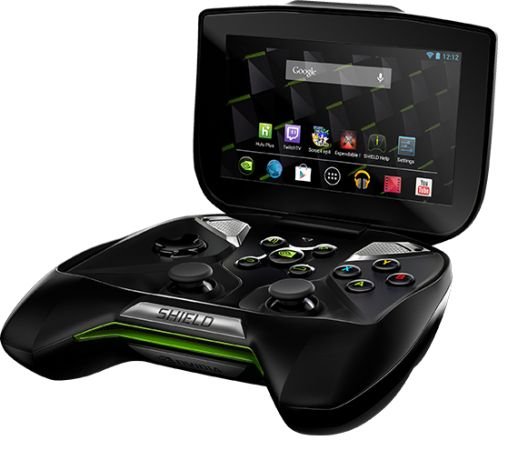With Tegra K1 and its Kepler GPU, Nvidia brings OpenGL 4.4, and not only OpenGL ES, to mobile devices, and the company is demo’ing OpenGL games such as Trine 2 on Tegra 4 reference tablet at CES 2014. Nvidia Tegra K1 Specifications In my initial post about Tegra K1 announcement, I missed some key features about Nvidia new processor which has now popped up on their website such as support for up to 8GB RAM, 4+1 configuration, etc and so listing a summary of the technical specifications of the 32-bit version may be useful: GPU – 192 NVIDIA CUDA cores using Kepler architecture CPU – NVIDIA 4-Plus-1 Quad-Core ARM Cortex-A15 “r3” up to 2.3 GHz Memory – DDR3L and LPDDR3, up to 8 GB with 40-bit address extension Display – LCD: Up to 3840×2160, HDMI: Up to 4K (UltraHD, 4096×2160) Package – 23×23 FCBGA, 16×16 S-FCCSP, or 15×15 FC PoP […]
Intel Unveils Edison Board for Wearables at CES 2014 Keynote
After an earlier Intel presentation about Intel RealSense Technology by Mooly Eden, Intel Senior Vice President and General Manager, the newly appointed Intel CEO, Brian Krzanich, officially opened CES 2014 with the pre-show keynote. This time there was nothing about processors for PCs, and the announcement the most interesting and relevant to this blog was Intel Edison, a tiny SD-card sized board powered by a dual core Quark SoC. Specifications: SoC – Unnamed and new dual core Intel Quark SoC @ 400MHz manufactured with 22nm process technology. MCU – Unnamed Intel MCU (MCS 51??) to manage I/Os and other baseline functions. System Memory – LPDDR2 Storage – NAND Flash Connectivity – Wi-Fi and Blutooth 4.0 LE Dimensions – Just like an SD card The board will support Linux, and common open source tools used by the marker community. It will also support Wolfgram language and Mathematica. There will also be […]
NVidia Announces Tegra K1 32-bit & 64-bit SoCs with a 192 Core Kepler GPU
Nvidia announced their newest mobile SoC at CES 2014, but instead of calling it Tegra 5, they went for Tegra K1, as it’s the first to feature a 192 cores GPU based on Kepler architecture, the same as used in PC graphics card. There will be several version of the chip one based on four Cortex A15 cores, one featuring a dual core Nvidia Denver CPU based on ARMv8 64-bit architecture, and Tegra K1 VCM for the automotive market. The company showcased the power of their new processor with an Unreal Engine 4 demo and the same face demo showed last year on an Nvidia GPU card, and Tegra K1 easily outperform older generations games console such as Xbox 360 and PlayStation 3, at and the same time consume just about 5 Watts of power, versus 100 Watts for Microsoft and Sony consoles. The GPU in the Tegra K1 also […]
Crowdfunding Report 2013 on CNXSoft Blog
Crowdfunding has really took off in 2013, with sites like Kickstarter and Indiegogo, as they enable start-ups to launch new and innovative products, and some established, even large companies, I’m thinking Canonical with Ubuntu Edge here, have also tapped into that market, actually shifting part of the risks from shareholders, to customers / individual funders. In this post, I’ll go through all the crowdfunding projects, 16 Indiegogo and 25 Kickstarter campaigns, featured on cnx-software.com between the beginning of December 2012 till the end of November 2013, to find out which ones have been a stellar success in terms of funding and on-time delivery, and those that have failed in one way or another, with some being close to looking like scams. There was a wide range of products with dealing home automation, the Internet of things, wireless Arduino compatible boards, Linux development boards, media players and more. Let’s go straight […]
GCW Zero Handheld Console Runs 3D Games via Open Source Vivante GPU Drivers (Etnaviv)
GCW Zero is an open source handheld gaming console featuring Ingenic JZ4770 MIPS processor with Vivante GC860 GPU, 512MB RAM, 16GB internal storage, and a 3.5″ LCD with 320×240 pixels. The device runs Linux (OpenDingux) , and retro games and emulators. GCW Zero had a successful kickstarter campaign, and is now available in a few shops such as ThinkGeek (US), DragonBox (EU) for $150 / 125 Euros. Today, I’m writing about this console, not because of amazing specs, nor price, but because it could be the first device with an embedded SoC that retails with an open source GPU driver. In September of this year, GCW Zero received a firmware update with Etnaviv GPU driver for Vivante GC860 adding support for 3D games via OpenGL ES support. The video below shows Quake 3 Arena running on the game console with the Etnaviv drivers. Lots of OpenGL ES1 and 2 features […]
The VERVE Connects Sensors Your Computer for Gaming, Monitoring, and More
The VERVE is a little box that connects to one of the USB port of your Windows or Mac OS X computer (Linux support coming in 2014), and supports up to 7 sensors. It is available as part of a kit for $99 on Kickstarter. The kit includes the VERVE, a mini USB to USB cable, seven “sensors” (A force sensor, a push button, a light sensor, a potentiometer, a motion sensor, a magnet sensor, and a touch sensor), two banana clips for the touch sensor, seven cables to connect the sensors to the VERVE unit, and 5 extension blocks. Once the VERVE unit is connected to your computer, and the needed sensors are connected to the VERVE, you can launch the VERVE application to visualize the sensors data in real-time, and assign a mouse or keyboard action based on the sensor’s data level as shown below. There’s also an […]
MK823 Android Set-Top Box Features AllWinner A31s SoC
AllWinner A31s is a cost down version of AllWinner A31 quad core Cortex A7 processor that is designed for phablets, with support for lower LCD and camera resolutions. This means A31s may actually be better choice than A31 for media players since few make use of LCD and/or camera interfaces. MK823 is the first media player I’ve heard of that use A31s processor. Here are the specifications of the device: SoC- Allwinner A31S quad-core Cortex A7 @ 1.0 GHz with PowerVR SGX544 MP2 GPU System Memory – 1GB DDR3 Storage – 8GB NAND Flash + SD card slot (up to 32GB) Video Output – HDMI 1.4 Connectivity: 10/100M Ethernet 802.11 b/g/n Wi-Fi Bluetooth 4.0 USB – 3x USB 2.0 Host port (including one OTG) Power Supply – 5V/2A Dimensions – N/A Weight – N/A This 4.2.2 Android TB box comes with a 5V/2A power adapter, an HDMI cable, a USB […]
NVIDIA Releases Source Code, Binaries, and Android Build Instructions for the SHIELD Gaming Console
This morning I’ve read bad news for the open source community. Jean-Baptiste Quéru, leader of the Android Open Source Project (AOSP) has decided to quit the project because AOSP cannot run on the latest Nexus 7 as Qualcomm (lawyers) impeded the project, and Google is unable to released factory images or necessary binary drivers for the GPU. But there’s also good news, as Nvidia has just released source code and binaries to allow developers to fully build an Android image for its SHIELD gaming console. If you want to build an image for the latest image available, following the steps below. Get the code
|
1 2 3 4 |
mkdir ~/shield-open-source cd ~/shield-open-source repo init -u git://nv-tegra.nvidia.com/manifest/android/binary.git -b rel-roth-ota-1-partner -m secureos/jb_roth.xml repo sync -j5 |
Build the Android image (Provided you’ve already setup your Linux PC do build AOSP):
|
1 2 3 4 5 6 7 8 9 |
cd ~/shield-open-source export TOP=`pwd` cd vendor/nvidia/licensed-binaries ./extract-nv-bins.sh cd $TOP . build/envsetup.sh setpaths lunch thor-userdebug mp dev |
Done (mp dev took about one hour for my machine). You should now have the required binary images in out/target/product/roth/ directory. Enter fastboot mode before flashing the binaries by one […]


